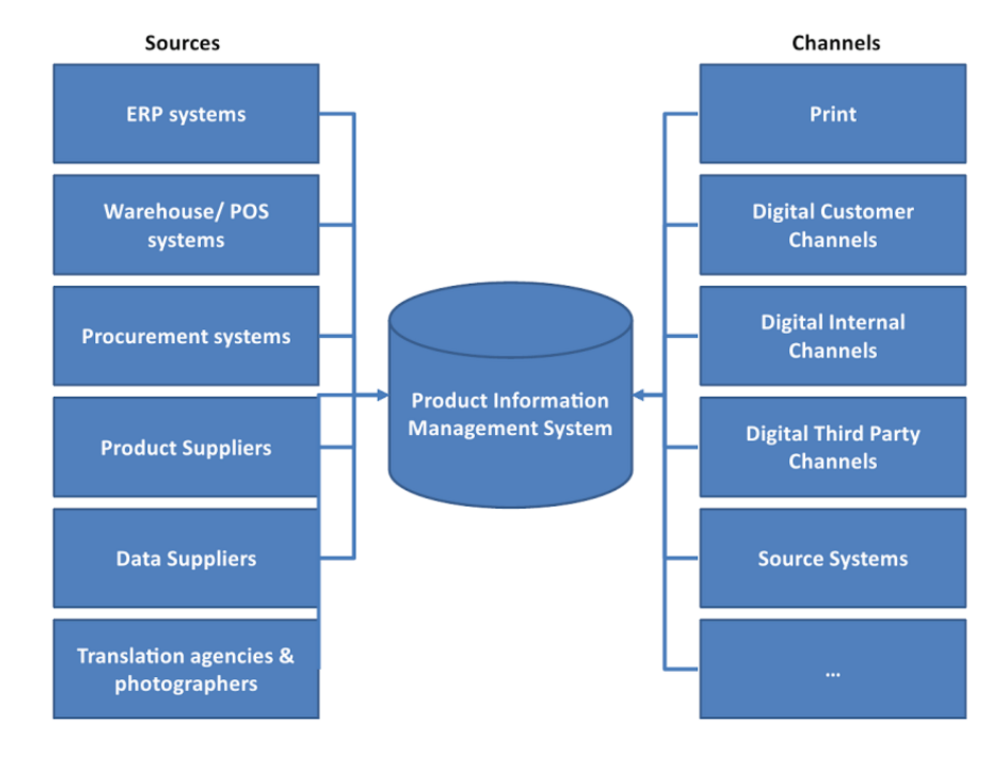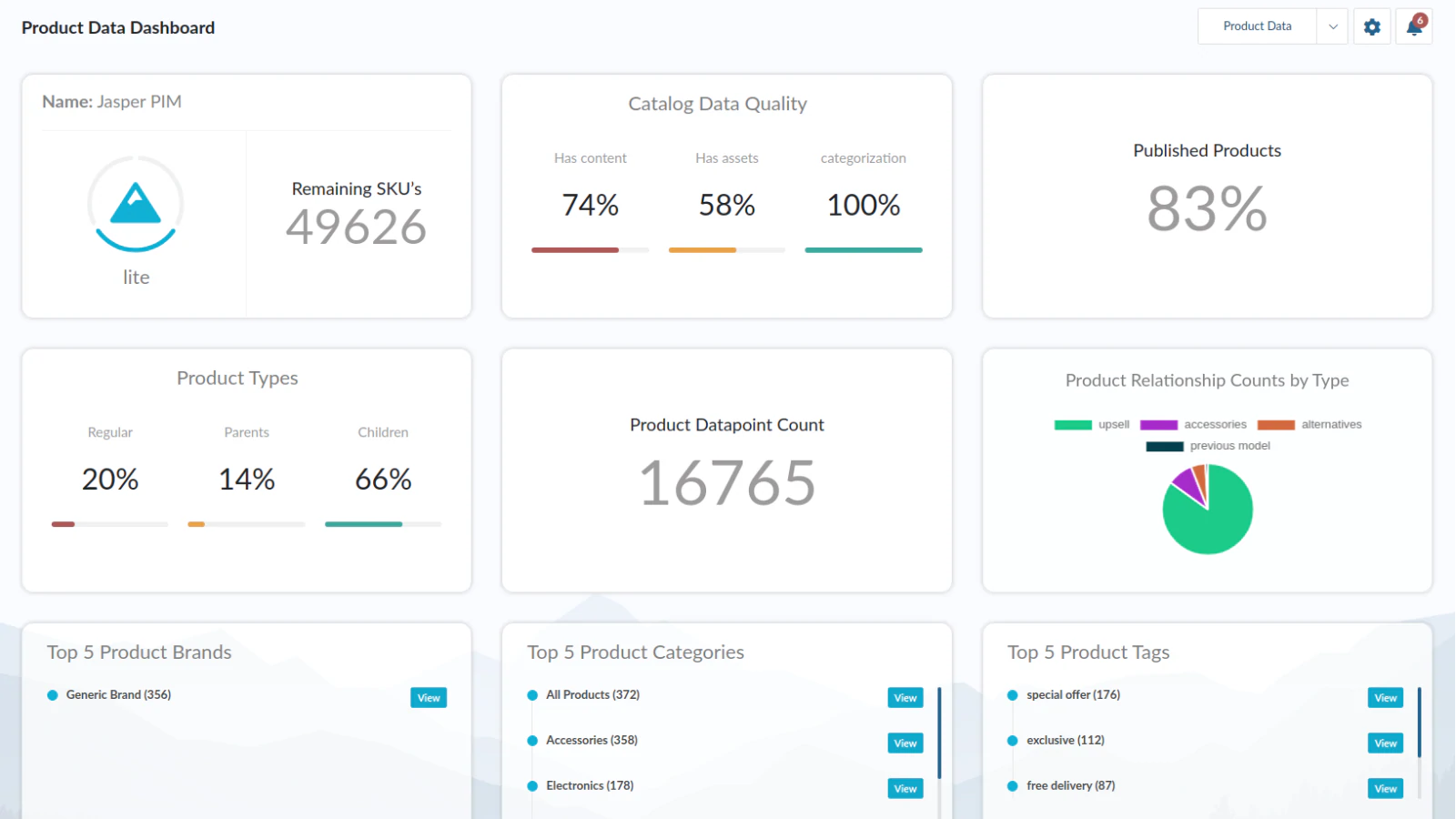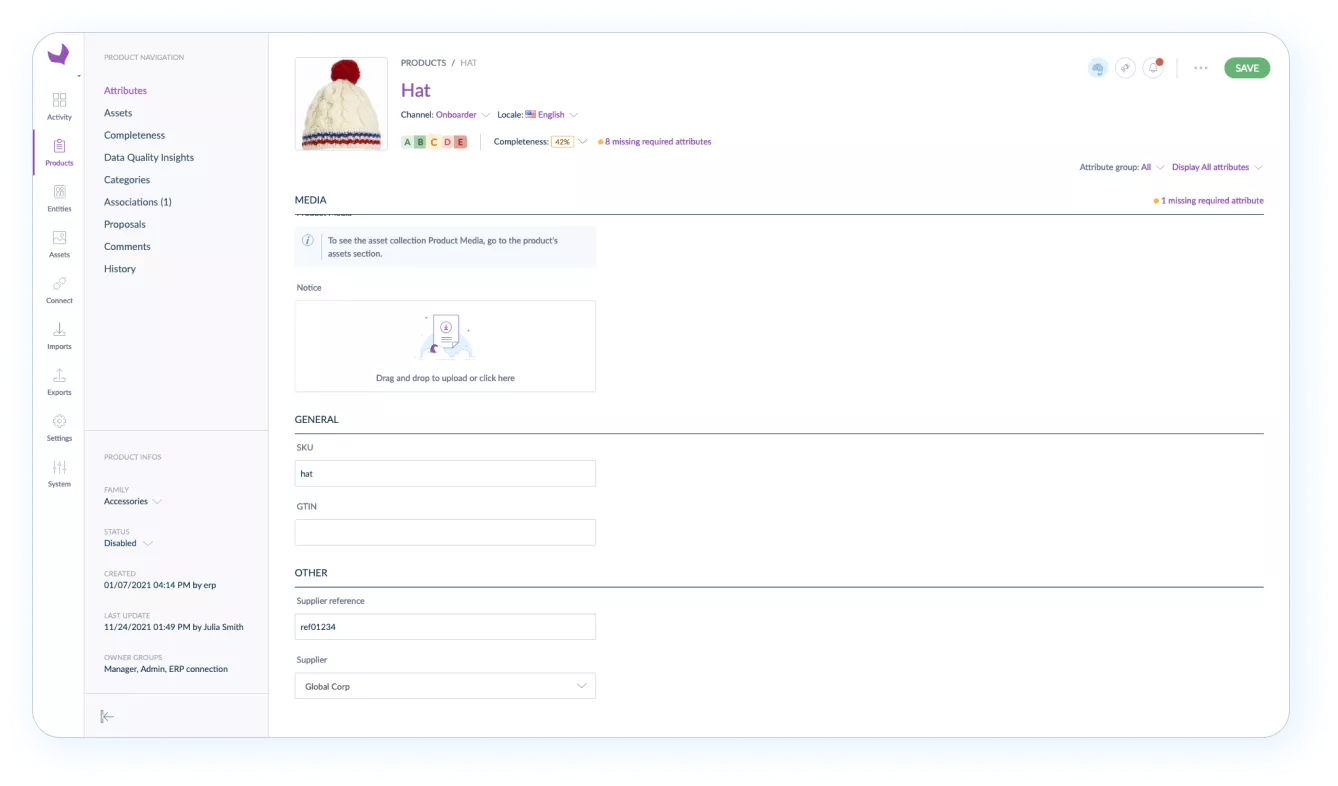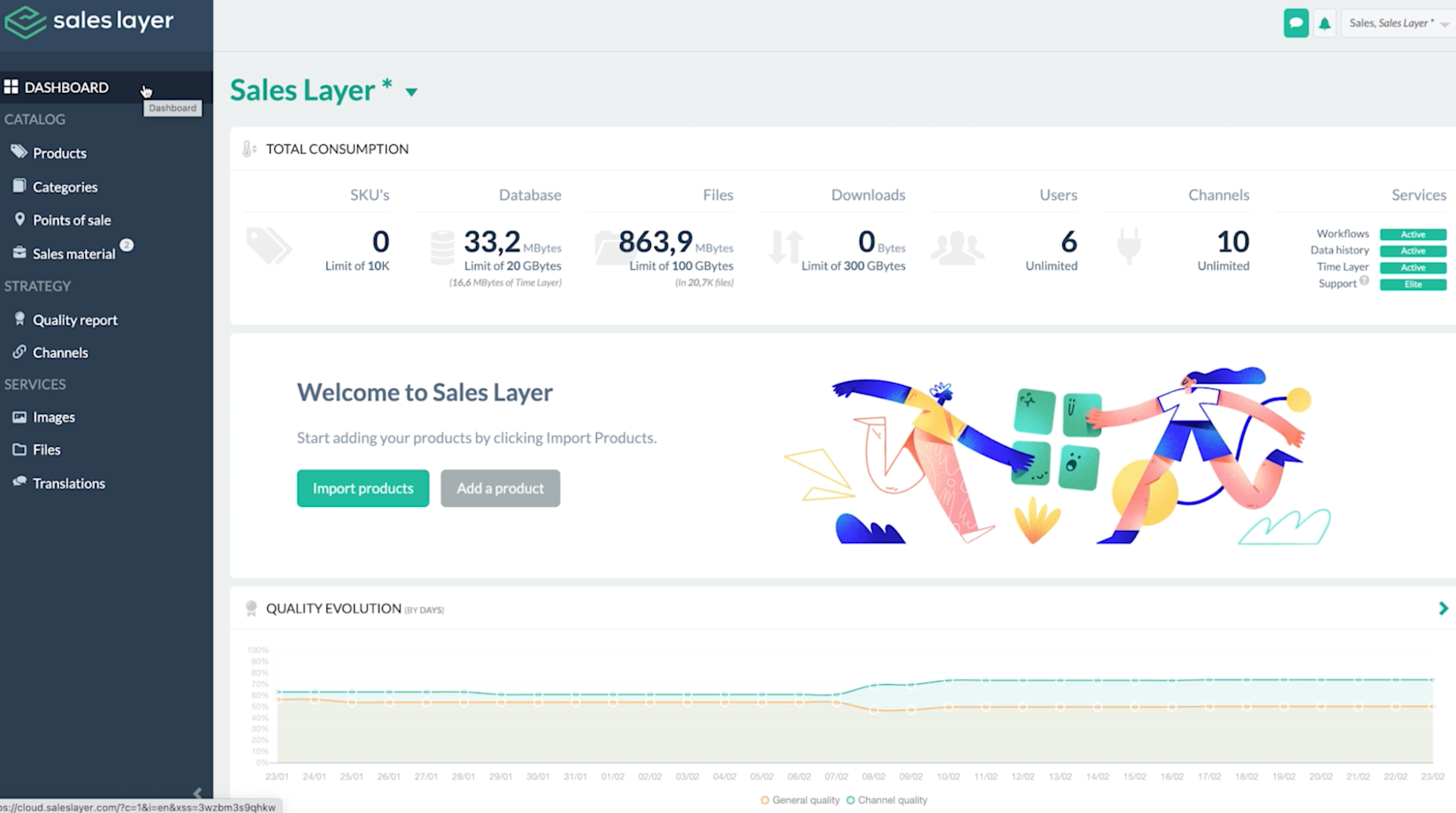You’re excited. You’ve just announced to the team that your business is ready to launch an international expansion strategy next year. Of course, the localization and currencies problem is just a minor one …
“We’ll just set up another store, and we’re set,” one of your ecommerce managers says.
Then, a product manager speaks up: “How on earth are we going to manage two or three times the product information and coordinate everything without third-party logistics?”
Maybe you’ve already crossed that line.
You knew managing the product information manually would be a nightmare, so you decided to set an automated system up to do it. You launched internationally, but it’s been a year since implementation, and now it’s hitting the fan. Whether that situation describes where you’re at or merely hints at some of the looming challenges, now is the time to evaluate how you’re handling and implementing product information management.
You’re not alone.
What is a product information management (PIM) system?
Product information management (PIM) is system that manages product data in order to market and sell across various channels. It takes all product data from every distribution channel and centralizes it into one place.

Image via “Product Information Management: Theory and Practice” by Abraham Jorji
You and your team can edit and manage all of your product information at once from the PIM system’s interface (e.g., item numbers, references, catalogs, SKU data, images and videos, translations, localizations, documentation, etc.).
Your PIM solution could provide product information to all sorts of stakeholders, from internal business operations through to suppliers, manufacturers, wholesalers, and customers.
Many companies consider a PIM when they have thousands of products to manage, but even stores with a limited number of products may invest in a PIM system.
Despite a seemingly limited product count, they might have a high set of variables and customizations. Or, if they’re expanding internationally, they might set up multiple stores as part of their localization process.
Table of contents
- Important PIM features
- Best PIM software
- Benefits of implementing a PIM solution
- What is the difference between a PIM and CRM?
- Is Shopify a PIM system?
Important PIM features
When you’re choosing a PIM for your business, there are a few things you need to look out for to make sure it works for you.
Any PIM system worth investing in should have at least some (if not all) of these features:
- Manual and automatic product information collection
- Ability to handle multiple SKUs
- Customizable fields for item information: product descriptions, product attributes, sizes, etc.
- Ability to manage substitutions, replacement parts, and accessories
- Workflow automation
- Content and marketing material management for each product
- Integration with your CMS, IMS, ERP, 3PL provider, and other parts of the ecommerce ecosystem
- Customizable workflows for different departments and parts of the supply chain
Essentially, if you’ve got a large product range and/or a complex range of different product types, making use of a PIM is definitely a good idea. It'll save you a lot of manual data entry and stop you getting confused between different SKUs when things get busy.
Best PIM software
Jasper PIM

Jasper PIM centralizes all the important information you need about your products into one powerful system. On the customer-facing side, it’ll store pictures, video, and marketing materials about each product, and behind the scenes it’ll store supplier, inventory, and category data.
Because it’s a Shopify app, Jasper integrates nicely into the platform and offers an enriched experience for Shopify stores, like enhanced search capability and automatic product syndication to your store.
With Jasper, you can:
- Serve the same products through multiple brands and storefronts in different languages
- Syndicate products automatically to ecommerce platforms
- Schedule product content updates and promo pricing
- Organize your products along with rich media content
Price: From $99/month. (at time of publishing)
Akeneo

Akeneo is an extensive product information management system that promises to organize and enrich your entire product catalog. It’s designed to cover a range of different business needs and strategies from direct to consumer, click and collect, or ship from store.
Akendo is an open-source SaaS PIM, which means there’s a range of pricing options to suit your scale, including a free option that requires some technical know-how and manual on-site installation. Or you can subscribe to a managed cloud version of the software.
Akeneos free PIM system includes the standard features you’d expect, while the paid growth and enterprise editions include:
- Cloud hosting
- Automation and governance
- Data quality enrichment
- Localized translations and measurements for different locations
- Supplier management tools
Price: Free to install on-site yourself, or from $25,000/year for managed subscription. (at time of publishing)
Plytix

Plytix is designed with team collaboration in mind, so everyone can access the right product information at the right time. From supply to logistics to sales and marketing, nobody will be confused about the status and specs of a product when they’re using Plytix.
The Plytix team is proud of their UX and design. The software is nicer to look at and easier to use than most of the competition (something you don’t always see in back end ecommerce business systems).
Its main features include:
- Unlimited users
- Filters and powerful search
- Digital asset management
- API for custom integrations
- Flexible variation handling
Price: Free plan available; $330/month for Standard; $1,200/month for Pro. (at time of publishing)
Sales Layer

Sales Layer is a cloud-based product information management system for product marketers. It’s a particularly user-friendly PIM platform that promises to enhance the customer experience by serving accurate content and data.
Sales Layer’s PIM has a notable focus on analytics: you can use it to analyze product information quality to ensure your catalog doesn’t have missing or incorrect data. This can be super useful for complex product ranges.
Features include:
- Real-time data updates
- Catalog status reports
- Digital asset management
- Workflow design and management
Price: Custom price available on request.
Catsy

Catsy is a user-friendly product data management platform that excels at helping you build catalogs. Its deeply customizable database functions can be used to make flyers, pricebooks, spec sheets, catalogs, and more. Its import wizards make it particularly easy to add new products and content without unnecessary manual entry.
It’s aimed more at brick-and-mortar stores and mail-order operations rather than ecommerce, but it’s still worth a look if you have lots of products that need organizing in a single place. Features include:
- Automated catalog building
- Pre-designed templates
- Catalog style customization
- Data can be fed to a wide range of marketing material
- Supports lots of formats and data types
- Great customer support
Price: Custom price available on request.
Salsify

Salsify is a PIM that supplies product data to the entire “digital shelf”—the various touchpoints that consumers encounter on their way to a purchase.
According to Salsify, “Product Information is the New Brand,” and it takes information quality very seriously.
Salsify brands its PIM as a ProductXM—product experience management—since the data it serves is so important to the end customer experience. It’s one of the more extensive options and is aimed at larger brand manufacturers, retailers, and distributors.
Features include:
- Enhanced content generation with custom templates
- Streamlined data import
- Automated data management workflows
- Maintains standards for data quality through the system
- Secure, SaaS-based architecture with regular updates
Price: Custom price available on request.
Benefits of implementing a PIM solution
Time efficiencies from reduced manual data entry
One of a PIM’s most obvious benefits is the time saved—think of all the manual data entry or frustrating search dead ends your team will no longer have to endure.
In his book Product Information Management: Theory and Practice, Abraham Jorij writes:
“According to Goodmasters, 25 min per SKU per year is spent on manual item data cleaning which would take only 4 min with automatic synchronization. In other words, 20 man months per 10,000 SKUs!”
Jorji also cites: “Before the introduction of a PIM system, less than 17% of staff at manufacturing companies spend less than 2 h per week searching for products. After implementation, this percentage had grown to 36%. For retailers, this percentage grew from 47% to 58%.”
Consistent, precise, information
From an operational and bottom line perspective, the benefits of a PIM are significant:
“Aberdeen sees in its research a 67% drop in labor cost. In a similar fashion, the Yankee Group reports an increase in employee productivity of 20%,” Jorji writes.
Looking beyond the time savings, he continues, “However, in our own case studies we do not see the cost savings being realized. While the above-mentioned cost reductions are valid, in reality the introduction of a PIM system rarely reduced operational costs. The cost savings are usually directly invested in creating better and more complete product information and/or supporting the long-tail strategy.”
That’s because most companies have a lot of inaccurate data. River Sand Solutions estimates that pharmaceutical manufacturers, distributors, and providers are operating at a 30% inaccuracy rate that has become the industry average.
Yet there’s an even more disturbing fact.
Jorji notes that this inaccuracy applies to all data, citing a stat from AT Kearney estimating that “30% of all article data from wholesale and producers has at least one mistake in it. It estimates the cost of correction to be between 60 € and 80 € per product.”
Jon Marsella, founder and CEO of Jasper Studios, says about inaccurate data: “Most of the time, [data] is messed up, it’s complex, it’s all over the place, and it’s inconsistent.”
While your team might save time entering data, that time gets reinvested into cleaning the information. With a PIM organizing all your information in one place, your team’s new mission is to ensure your data is as accurate as possible.
Cost savings from improved logistics
With improved information accuracy comes the return on investment via cost savings. According to Heiler (via Jorji), companies investing in PIM see up to 23% fewer product returns.
Yankee Group senior analyst Kosin Huang reinforces this finding: “For companies that have deployed PIM, the annual business improvement averages 25 percent. … Suppliers alike recognize the impact of PIM and will use their PIM IT strategy to differentiate themselves to retailers as preferred partners that can showcase impressive supply chain success.”
With a PIM, Proctor & Gamble discovered that 3.6% of its orders included obsolete products. Johnson & Johnson discovered that inaccurate product data caused 2.5% out of stocks with its largest retailer, Walmart.
Both are real-world examples of how PIM can drive business improvement.
What is the difference between a PIM and CRM?
The difference between a PIM and a customer relationship management (CRM) system lies in the data they manage.
CRMs manage customer information. This means they contain and organize all the data you gather about customers: from their beginnings as a lead, all the way through your funnel to making a purchase and becoming loyal repeat buyers. The purpose of a CRM is to understand and strengthen relationships with people who buy from you and are considering buying from you.
PIMs deal with product information. A PIM is designed to store and manage everything about the products themselves, in an extensive, connected database. It’ll contain the technical specs of a product, its category information, content and metadata about it, and other related data variants.
The overall intention is to be the single source of truth about each individual product, which other systems can receive info from—for example, product pages on an ecommerce site.
CRMs and PIMs can happily exist alongside one another. They’re both subsets of MDM—master data management—which refers to the organization of all the data throughout a business.
They can exchange data and work together to provide an efficient system for managing a store and getting the right product to the right customer.
Is Shopify a PIM system?
Shopify is not a PIM system itself, although it does integrate well with PIMs.
Shopify is a platform and set of tools that enable you to run a thriving ecommerce store. However, it doesn't act as a central repository for your entire product range. Instead, if you use a PIM, Shopify can make use of its data and bring it to your storefront.
Shopify isn’t really designed as a content management solution, so if your omnichannel approach requires lots of different photos, videos, or metadata to be pushed out through various distribution channels, a PIM is something you should look at investing in.
If you're a Shopify customer and you think you’d benefit from using a PIM, we’d recommend trying out some of the systems listed above.
But the real problem … PIM is oversimplified
When I started this article, one of my esteemed colleagues warned, “Most people come into PIM with an oversimplified worldview. We don’t want to oversimplify the issue with a trite article.”
Ain’t that the truth.
Jon Marsella from Jasper says, “When companies attempt to implement a PIM on their own, I think where it really falls down is understanding how far and how deeply integrated the reach of their products is, and how many manual processes they’re using.”
“They don’t anticipate how much work is involved in integrating with these things. Most of our clients and prospects that we encounter have products all over the place. They have them in over a dozen places sometimes, and have various departments managing it.”
This applies to organizations of all sizes. Marsella continues: “Even smaller organizations might underestimate a few things. For example, the number of touch points it takes to make your PIM effective, really get your PIM to become the brains of the operation, which in our view is the way to go, as far as the architecture is concerned.”
Examples abound: product taxonomies, product mappings, all of the complexity around product child/parents, bundling products, and discounts. And then there are the potential limitations of online marketplace sales channels such as eBay and Amazon.
Marsella says, “When companies go to implement their own PIMs, they also have to consider how to implement their touch points and connectors, and those are death by a thousand cuts.”
Moreover, PIM is not a purely technical solution to an organizational problem. Successful PIM implementation requires rethinking how your company manages information flow, and will test your team’s communication workflows.
Ernst & Young Principal Can A. Dogan wrote for Supply Chain Quarterly about how companies tend to overemphasize technology’s role in achieving inventory management objectives:
“Industries are littered with companies that have de-emphasized critical elements such as processes, policies, people skills, organizational design, data reliability, metrics, analytics, and reporting by focusing primarily on technology enablement. These companies often find themselves weighed down with systems that are, at best, never fully leveraged, and, at worst, simply abandoned over time.”
Make sure yours avoids a similar fate.
PIM as a business performance driver
Most people see PIM as an expense to be minimized. And with the incredible amount of cost savings that comes with information precision, that’s not an unreasonable suggestion.
But a PIM reaches its full potential when it’s used not just as a supply chain function, but as an asset to drive business performance.
As Marsella highlighted earlier, the benefits include expanding markets and spaces your business couldn’t access before, getting products to market faster (4 times, on average). It could also mean enabling sales by providing the entire team, and other parties, with easy access to documents and publishing, or marketing by automating digital marketing and social campaigns.
Ecommerce PIM FAQs
What is an ecommerce PIM?
An ecommerce PIM, product information management, is an application that stores and creates product catalogs and can be distributed throughout a store's sales channels.
What should a PIM do for an ecommerce store?
A PIM should integrate with a CMS, ERP, and 3PL, as well as manage content for products, create automatic workflows, handle many SKUS, and have many fields for product customizations.
What is the best PIM software?
There are seven different PIM software that an ecommerce store should consider:
- Jasper
- Akeneo
- Plytix
- Sales Layer
- Catsy
- Salsify
The best ecommerce PIM depends on the business needs and unique features the software provides.
Read More
- Resources to Help Merchants Get Online Fast, Optimize Stores, and Scale
- Ecommerce Chatbots: 22 Ways to Increase Sales, Conversions & Retention
- How 3 Brands Scaled Their Ecommerce Subscription Model 100-350%
- B2B Ecommerce Features for Acquiring, Selling & Retaining Customers
- Facebook Messenger Marketing Flows You can Copy and Paste
- What Is Curbside Pickup (Click and Collect)?
- Marketing Calendars for 2018’s Holidays: Ecommerce, Social & Sales
- Ecommerce Basics: A 101 Guide
- 11 Ecommerce Checkout Best Practices: Improve the Checkout Experience and Increase Conversions






